Attached files
| file | filename |
|---|---|
| EX-99.1 - EXHIBIT 99.1 - ACI WORLDWIDE, INC. | aciw-20200227ex991.htm |
| 8-K - 8-K - ACI WORLDWIDE, INC. | aciw-202002278k.htm |

Exhibit 99.2 ACI WORLDWIDE February 27, 2020 QUARTERLY AND FULL-YEAR 2019 EARNINGS PRESENTATION
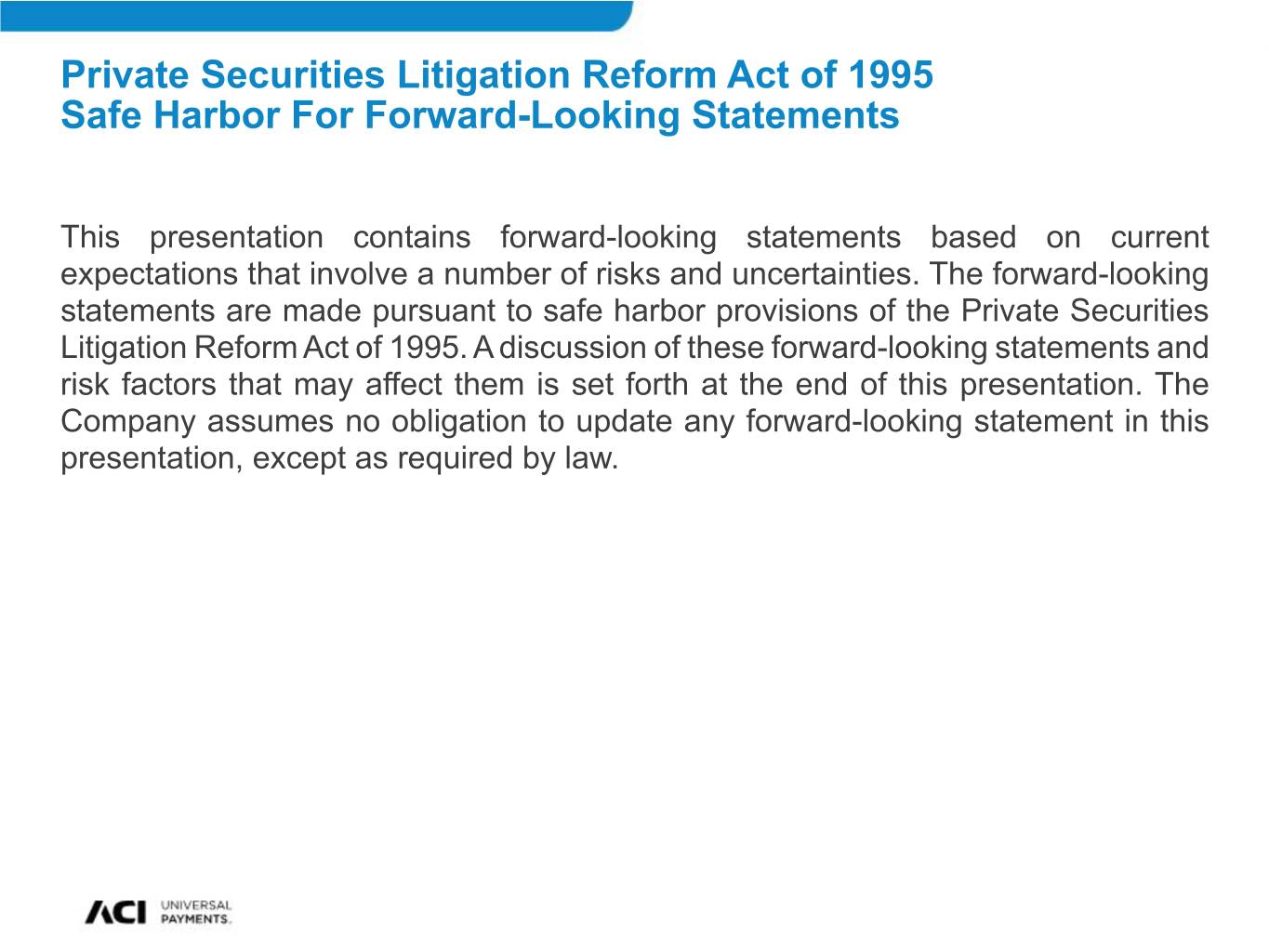
Private Securities Litigation Reform Act of 1995 Safe Harbor For Forward-Looking Statements This presentation contains forward-looking statements based on current expectations that involve a number of risks and uncertainties. The forward-looking statements are made pursuant to safe harbor provisions of the Private Securities Litigation Reform Act of 1995. A discussion of these forward-looking statements and risk factors that may affect them is set forth at the end of this presentation. The Company assumes no obligation to update any forward-looking statement in this presentation, except as required by law.
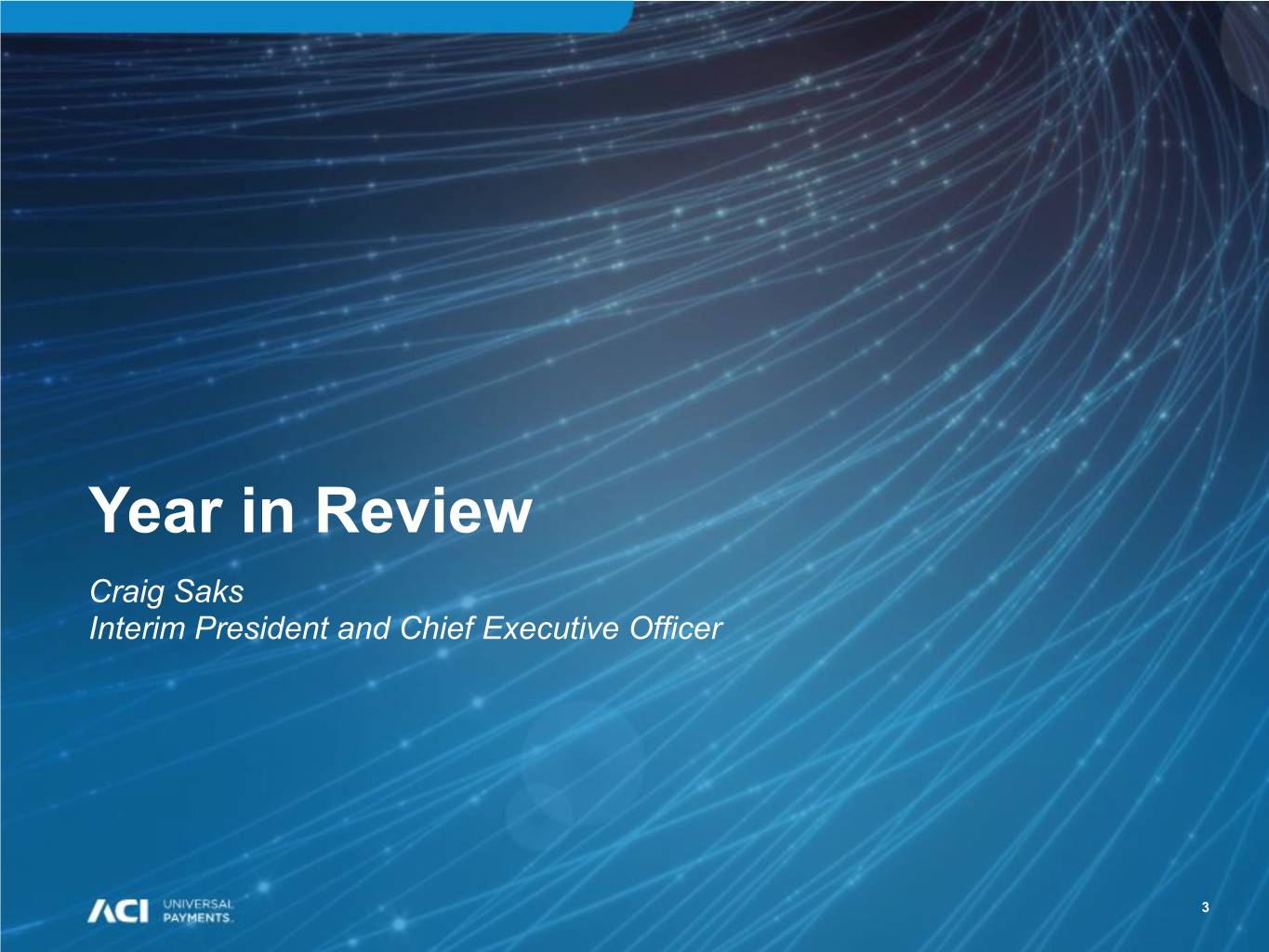
Year in Review Craig Saks Interim President and Chief Executive Officer 3

2019 Year in Review ◦ 2019 revenue up 25% ◦ Adjusted EBITDA grew 23% ◦ Speedpay acquisition materially improved profitability of ACI On Demand ◦ ACI recurring revenue increased to more than 70% ◦ 2020 pipeline is strong 4

Financial Review Scott Behrens Chief Financial Officer 5

Key Takeaways from the Year • Bookings – Total bookings were $1.2 billion in 2019 • Backlog* – 12-month backlog of $1.1 billion, up $18 million – 60-month backlog of $5.8 billion, up $144 million • Revenue and Adjusted EBITDA – On Demand revenue increased 57% from 2018 – On Demand net adjusted EBITDA margin improved to 19% versus 5% in 2018 – On Premise revenue increased slightly from 2018 – On Premise adjusted EBITDA margin was 55% • Debt and Liquidity – Adjusted operating free cash flow was $108 million, versus $148 million in 2018 – Ended year with $121 million in cash and $1.4 billion in debt – Proforma net debt/EBITDA of 3.75x – Repurchased 1.2 million shares for $36 million ($29 per share) – $141 million remaining on share repurchase authorization *Adjusted for Fx and the Speedpay acquisition 6

2020 Guidance 2019 2020 Guidance Growth 2020 Guidance (millions) Actuals Low High Over 2019 Revenue $1,258 $1,480 $1,510 18-20% Adjusted EBITDA $308 $425 $445 38-44% ◦ 2019 actuals includes partial year contribution of $228 million from Speedpay, acquired May 9, 2019; on a pro forma basis, Speedpay generated $354 million in revenue during 2019 ◦ 2020 guidance excludes between $5 million and $10 million in one-time significant transaction-related expenses and $10 million of one-time charges to implement cost reduction strategies ◦ We expect revenue to be between $285 million and $295 million in Q1 2020 ◦ Interest expense of $65 million and cash interest of $60 million ◦ Capital expenditures of $55 million to $60 million ◦ Depreciation and amortization to approximate $130 million ◦ Non-cash compensation expense to approximate $35 million ◦ Pass through interchange revenues to approximate $390 million ◦ Cash taxes expected to approximate $40 million ◦ Effective tax rate expected to approximate 25% ◦ Diluted share count to approximate 119 million (excluding future share buy-back activity) 7

Appendix 8
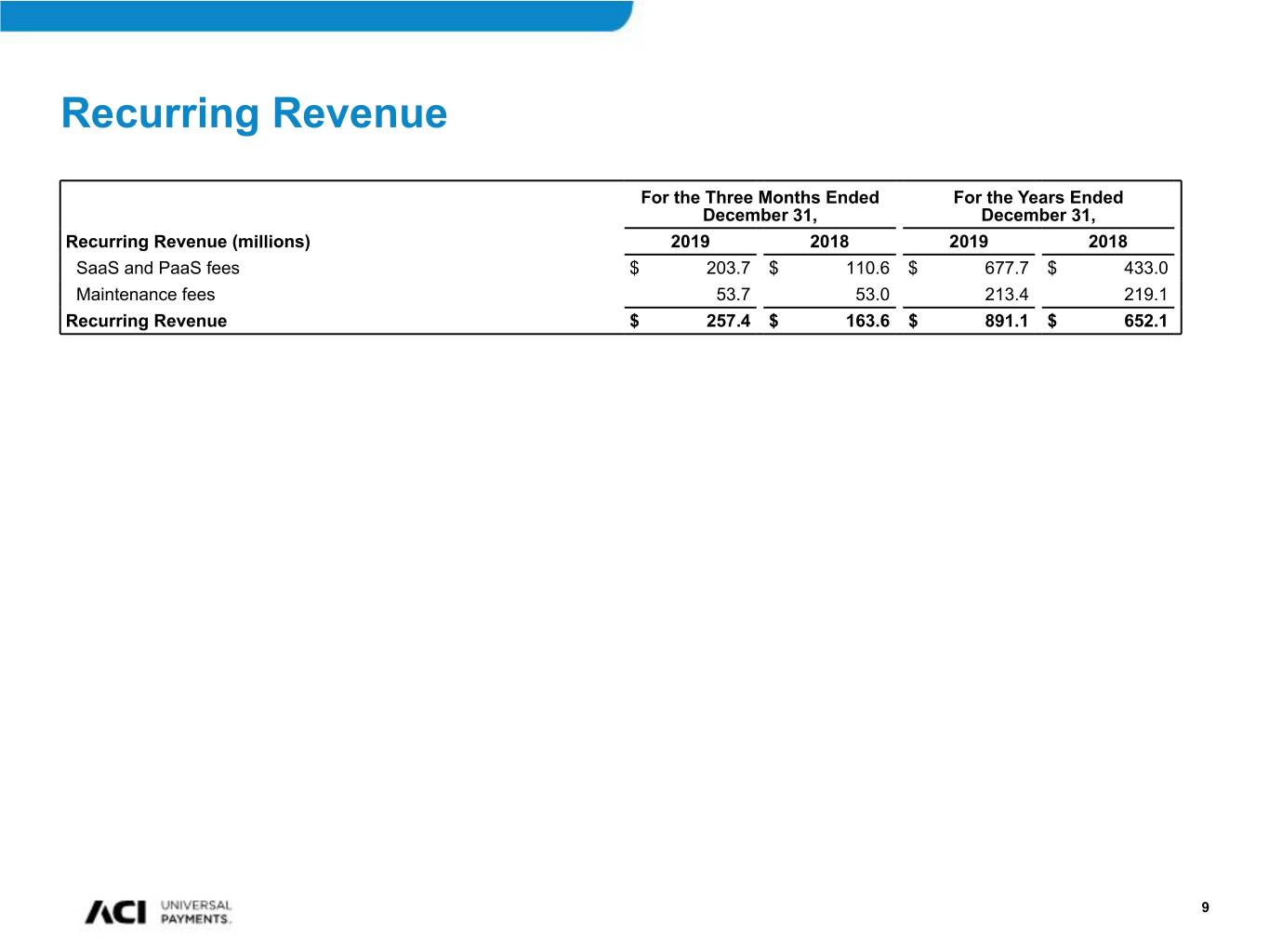
Recurring Revenue For the Three Months Ended For the Years Ended December 31, December 31, Recurring Revenue (millions) 2019 2018 2019 2018 SaaS and PaaS fees $ 203.7 $ 110.6 $ 677.7 $ 433.0 Maintenance fees 53.7 53.0 213.4 219.1 Recurring Revenue $ 257.4 $ 163.6 $ 891.1 $ 652.1 9

Historic Bookings By Quarter (thousands) Bookings Mix by Category New Accounts / Add-on Term Quarter-End Total Bookings New Applications Business Extension 3/31/2017 $184,492 $20,759 $68,044 $95,689 11% 37% 52% 6/30/2017 $206,094 $53,521 $83,363 $69,209 26% 40% 34% 9/30/2017 $213,366 $74,978 $67,818 $70,570 35% 32% 33% 12/31/2017 $488,900 $92,364 $157,857 $238,678 19% 32% 49% 3/31/2018 $265,809 $142,112 $72,800 $50,897 53% 27% 19% 6/30/2018 $197,616 $44,783 $82,528 $70,306 23% 42% 36% 9/30/2018 $292,470 $76,716 $47,600 $168,155 26% 16% 57% 12/31/2018 $506,103 $129,021 $161,917 $215,164 25% 32% 43% 3/31/2019 $111,735 $29,552 $40,246 $41,937 26% 36% 38% 6/30/2019 $300,656 $65,428 $63,244 $171,984 22% 21% 57% 9/30/2019 $222,225 $62,977 $76,696 $82,552 28% 35% 37% 12/31/2019 $604,609 $65,838 $138,790 $399,982 11% 23% 66% New Accounts / Add-on Term Total Bookings New Applications Business Extension Dec YTD 19 $1,239,225 $223,795 $318,975 $696,455 Dec YTD 18 $1,261,998 $392,632 $364,845 $504,522 Variance $(22,773) $(168,837) $(45,869) $191,933 10

Adjusted EBITDA and Segmented Data For the Three Months Ended For the Years Ended Adjusted EBITDA (millions) December 31, December 31, 2019 2018 2019 2018 Net income $ 55.5 $ 87.7 $ 67.1 $ 68.9 Plus: Income tax expense 35.2 21.1 5.1 22.9 Net interest expense 15.2 7.0 52.1 30.4 Net other (income) expense (3.4) 0.7 (0.5) 3.7 Depreciation expense 6.2 5.9 24.1 23.8 Amortization expense 27.9 18.6 98.5 73.5 Non-cash stock-based compensation expense 6.4 (0.3) 36.8 20.4 Adjusted EBITDA before significant transaction-related expenses $ 143.0 $ 140.7 $ 283.2 $ 243.6 Significant transaction-related expenses 2.7 0.9 24.9 7.4 Adjusted EBITDA $ 145.7 $ 141.6 $ 308.1 $ 251.0 For the Three Months Ended For the Years Ended Segment Information (millions) December 31, December 31, 2019 2018 2019 2018 Revenue ACI On Premise $ 196.2 $ 209.3 $ 579.3 $ 576.8 ACI On Demand 203.7 110.7 679.0 433.0 Total Revenue $ 399.9 $ 320.0 $ 1,258.3 $ 1,009.8 Segment Adjusted EBITDA ACI On Premise $ 136.4 $ 152.4 $ 321.3 $ 323.9 ACI On Demand $ 30.9 $ 16.3 $ 66.5 $ 12.0 11

Adjusted Operating Free Cash Flow and 60-Month Backlog For the Three Months Ended For the Years Ended Reconciliation of Adjusted Operating Free Cash Flow (millions) December 31, December 31, 2019 2018 2019 2018 Net cash flows from operating activities $ 48.7 $ 83.5 $ 137.6 $ 183.9 Net after-tax payments associated with significant transaction-related expenses 0.4 0.6 18.4 7.5 Less: capital expenditures (10.7) (5.6) (48.0) (43.9) Adjusted Operating Free Cash Flow $ 38.4 $ 78.5 $ 108.0 $ 147.5 For the Three Months Ended December 31, September 30, June 30, March 31, December 31, Backlog 60-Month (millions) 2019 2019 2019 2019 2018 ACI On Premise $ 1,977 $ 1,925 $ 1,880 $ 1,861 $ 1,875 ACI On Demand 3,855 3,756 3,813 2,290 2,299 Backlog 60-Month $ 5,832 $ 5,681 $ 5,693 $ 4,151 $ 4,174 12

EPS Impact of Non-Cash and Significant Transaction-Related Items EPS impact of non-cash and significant transaction-related items For the Three Months Ended December 31, (millions) 2019 2018 $ in Millions $ in Millions EPS Impact (Net of Tax) EPS Impact (Net of Tax) GAAP net income $ 0.47 $ 55.5 $ 0.74 $ 87.7 Adjusted for: Significant transaction-related expenses 0.02 2.0 0.01 0.7 Amortization of acquisition-related intangibles 0.06 7.1 0.03 3.7 Amortization of acquisition-related software 0.07 8.2 0.05 5.8 Non-cash stock-based compensation 0.04 4.9 — (0.2) Total adjustments $ 0.19 $ 22.2 $ 0.09 $ 10.0 Diluted EPS adjusted for non-cash and significant transaction- related items $ 0.66 $ 77.7 $ 0.83 $ 97.7 EPS impact of non-cash and significant transaction-related items For the Years Ended December 31, (millions) 2019 2018 $ in Millions $ in Millions EPS Impact (Net of Tax) EPS Impact (Net of Tax) GAAP net income $ 0.57 $ 67.1 $ 0.59 $ 68.9 Adjusted for: Tax benefit from release of valuation allowances (0.13) (15.5) — — Significant transaction-related expenses 0.16 18.9 0.05 5.7 Amortization of acquisition-related intangibles 0.20 24.2 0.13 15.0 Amortization of acquisition-related software 0.24 29.0 0.20 23.6 Non-cash stock-based compensation 0.24 27.9 0.14 16.1 Total adjustments $ 0.71 $ 84.5 $ 0.52 $ 60.4 Diluted EPS adjusted for non-cash and significant transaction- related items $ 1.28 $ 151.6 $ 1.11 $ 129.3 13

Contract Duration Metric ◦ Represents dollar average remaining contract life (in years) for term license software contracts ◦ Excludes perpetual contracts (primarily acquired software contracts) ◦ Excludes all On Demand contracts as both cash and revenue are ratable over the contract term 14

Non-GAAP Financial Measures To supplement our financial results presented on a GAAP basis, we use the non-GAAP measures indicated in the tables, which exclude significant transaction related expenses, one-time charges to implement cost reduction strategies, as well as other significant non-cash expenses such as depreciation, amortization, and non-cash compensation, that we believe are helpful in understanding our past financial performance and our future results. The presentation of these non-GAAP financial measures should be considered in addition to our GAAP results and are not intended to be considered in isolation or as a substitute for the financial information prepared and presented in accordance with GAAP. Management generally compensates for limitations in the use of non-GAAP financial measures by relying on comparable GAAP financial measures and providing investors with a reconciliation of non-GAAP financial measures only in addition to and in conjunction with results presented in accordance with GAAP. We believe that these non-GAAP financial measures reflect an additional way to view aspects of our operations that, when viewed with our GAAP results, provide a more complete understanding of factors and trends affecting our business. Certain non-GAAP measures include: ◦ Adjusted EBITDA: net income plus income tax expense, net interest income (expense), net other income (expense), depreciation, amortization, and non-cash compensation, as well as significant transaction related expenses and one-time charges to implement cost reduction strategies. Adjusted EBITDA should be considered in addition to, rather than as a substitute for, net income. ◦ Net Adjusted EBITDA Margin: Adjusted EBITDA divided by revenue net of pass through interchange revenue. Net Adjusted EBITDA Margin should be considered in addition to, rather than as a substitute for, net income. 15

Non-GAAP Financial Measures ACI is also presenting adjusted operating free cash flow, which is defined as net cash provided by operating activities and net after-tax payments associated with significant transaction-related expenses, less capital expenditures. Adjusted operating free cash flow is considered a non-GAAP financial measure as defined by SEC Regulation G. We utilize this non- GAAP financial measure, and believe it is useful to investors, as an indicator of cash flow available for debt repayment and other investing activities, such as capital investments and acquisitions. We utilize adjusted operating free cash flow as a further indicator of operating performance and for planning investment activities. Adjusted operating free cash flow should be considered in addition to, rather than as a substitute for, net cash provided by operating activities. A limitation of adjusted operating free cash flow is that it does not represent the total increase or decrease in the cash balance for the period. This measure also does not exclude mandatory debt service obligations and, therefore, does not represent the residual cash flow available for discretionary expenditures. We believe that adjusted operating free cash flow is useful to investors to provide disclosures of our operating results on the same basis as that used by our management. ACI also includes backlog estimates, which include all license, maintenance, and services revenue (including SaaS and Platform) specified in executed contracts, as well as revenues from assumed contract renewals to the extent that we believe recognition of the related revenue will occur within the corresponding backlog period. We have historically included assumed renewals in backlog estimates based upon automatic renewal provisions in the executed contract and our historic experience with customer renewal rates. 16

Non-GAAP Financial Measures Backlog is considered a non-GAAP financial measure as defined by SEC Regulation G. Our 60-month backlog estimates are derived using the following key assumptions: • License arrangements are assumed to renew at the end of their committed term or under the renewal option stated in the contract at a rate consistent with historical experience. If the license arrangement includes extended payment terms, the renewal estimate is adjusted for the effects of a significant financing component. • Maintenance fees are assumed to exist for the duration of the license term for those contracts in which the committed maintenance term is less than the committed license term. • SaaS and PaaS arrangements are assumed to renew at the end of their committed term at a rate consistent with our historical experiences. • Foreign currency exchange rates are assumed to remain constant over the 60-month backlog period for those contracts stated in currencies other than the U.S. dollar. • Our pricing policies and practices are assumed to remain constant over the 60-month backlog period. Estimates of future financial results are inherently unreliable. Our backlog estimates require substantial judgment and are based on a number of assumptions as described above. These assumptions may turn out to be inaccurate or wrong, including, but not limited to, reasons outside of management’s control. For example, our customers may attempt to renegotiate or terminate their contracts for a number of reasons, including mergers, changes in their financial condition, or general changes in economic conditions in the customer’s industry or geographic location, or we may experience delays in the development or delivery of products or services specified in customer contracts which may cause the actual renewal rates and amounts to differ from historical experiences. Changes in foreign currency exchange rates may also impact the amount of revenue actually recognized in future periods. Accordingly, there can be no assurance that contracts included in backlog estimates will actually generate the specified revenue or that the actual revenue will be generated within the corresponding 60-month period. Backlog estimates should be considered in addition to, rather than as a substitute for, reported revenue and contracted but not recognized revenue (including deferred revenue). 17
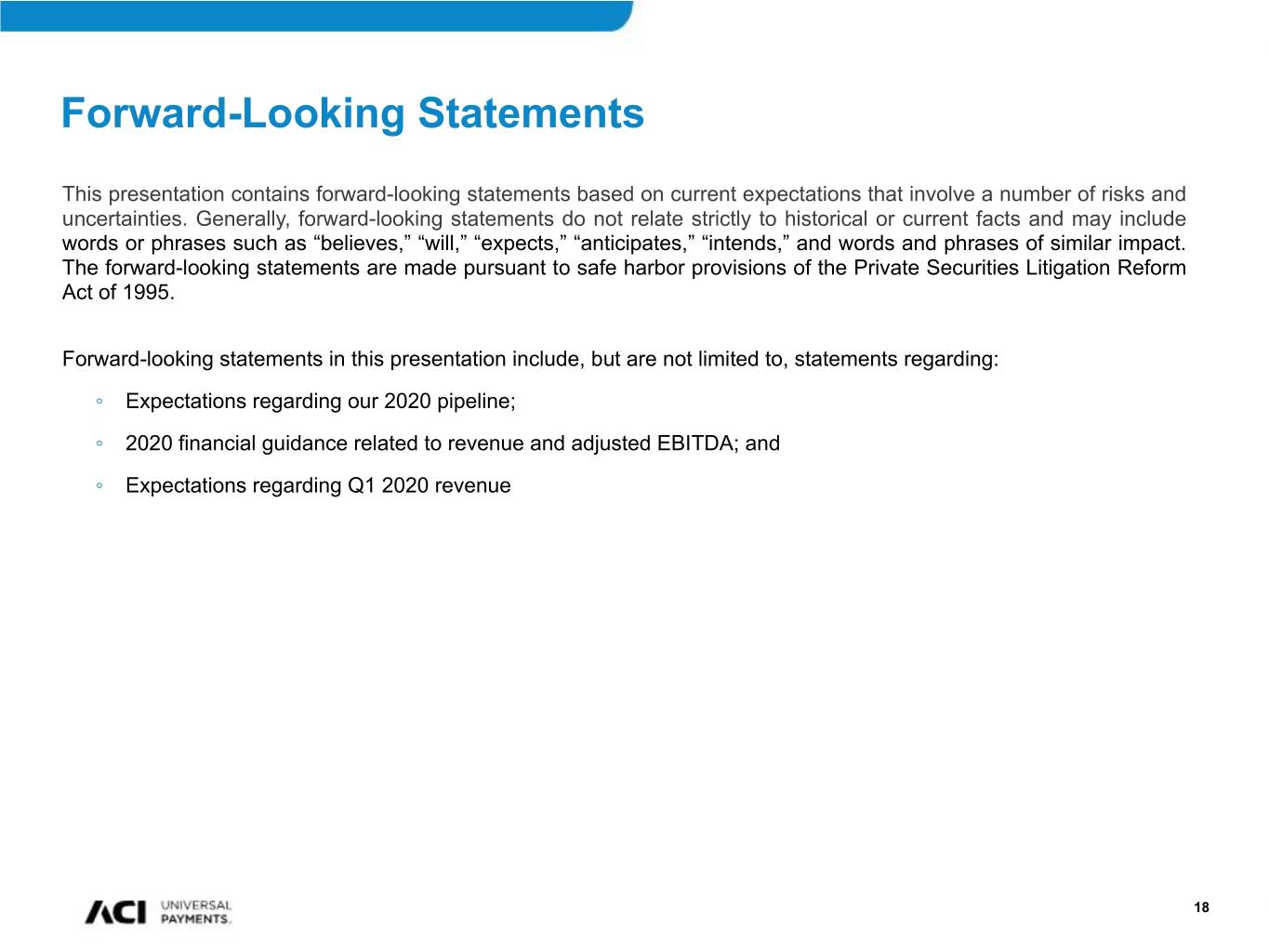
Forward-Looking Statements This presentation contains forward-looking statements based on current expectations that involve a number of risks and uncertainties. Generally, forward-looking statements do not relate strictly to historical or current facts and may include words or phrases such as “believes,” “will,” “expects,” “anticipates,” “intends,” and words and phrases of similar impact. The forward-looking statements are made pursuant to safe harbor provisions of the Private Securities Litigation Reform Act of 1995. Forward-looking statements in this presentation include, but are not limited to, statements regarding: ◦ Expectations regarding our 2020 pipeline; ◦ 2020 financial guidance related to revenue and adjusted EBITDA; and ◦ Expectations regarding Q1 2020 revenue 18
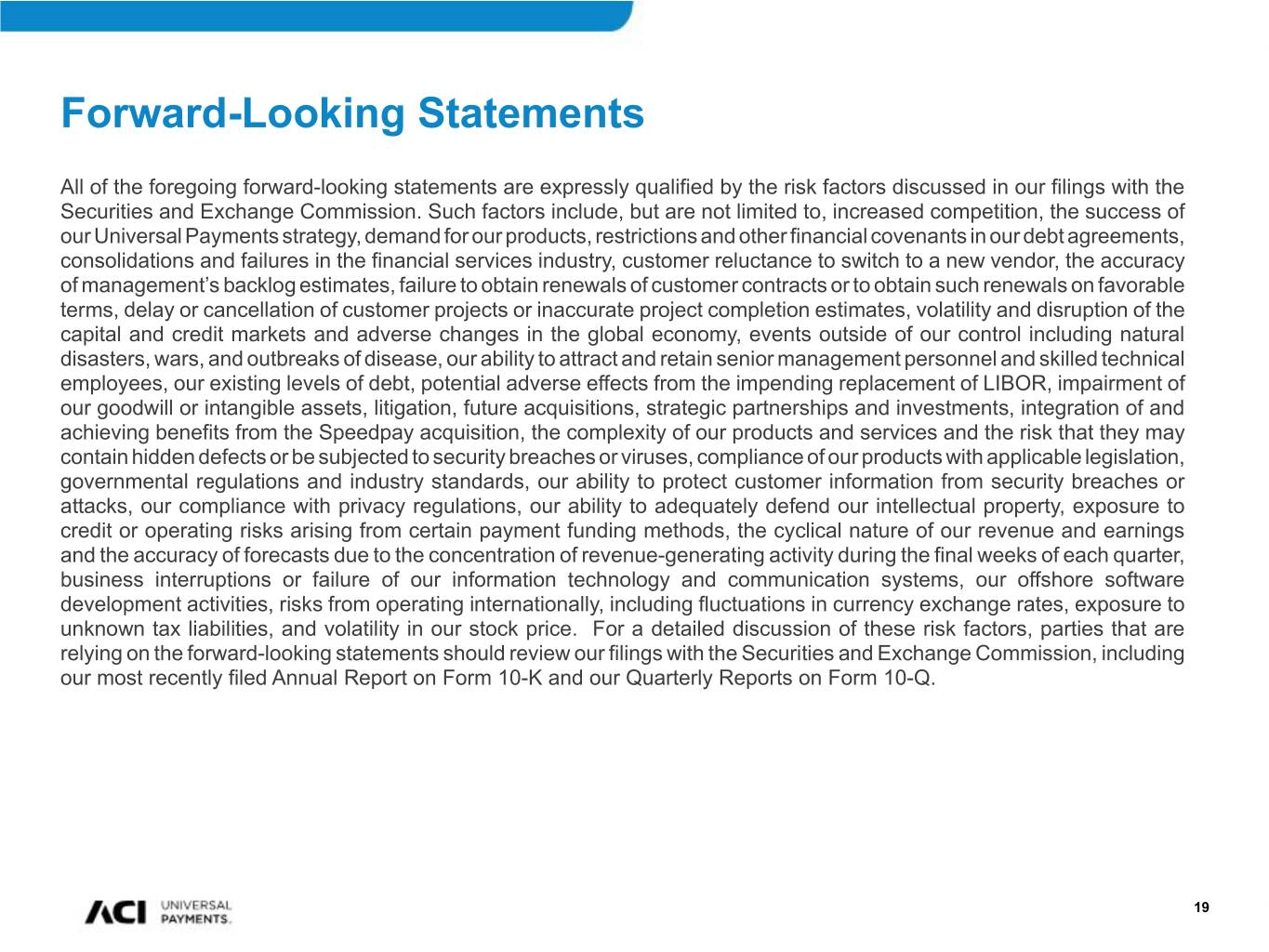
Forward-Looking Statements All of the foregoing forward-looking statements are expressly qualified by the risk factors discussed in our filings with the Securities and Exchange Commission. Such factors include, but are not limited to, increased competition, the success of our Universal Payments strategy, demand for our products, restrictions and other financial covenants in our debt agreements, consolidations and failures in the financial services industry, customer reluctance to switch to a new vendor, the accuracy of management’s backlog estimates, failure to obtain renewals of customer contracts or to obtain such renewals on favorable terms, delay or cancellation of customer projects or inaccurate project completion estimates, volatility and disruption of the capital and credit markets and adverse changes in the global economy, events outside of our control including natural disasters, wars, and outbreaks of disease, our ability to attract and retain senior management personnel and skilled technical employees, our existing levels of debt, potential adverse effects from the impending replacement of LIBOR, impairment of our goodwill or intangible assets, litigation, future acquisitions, strategic partnerships and investments, integration of and achieving benefits from the Speedpay acquisition, the complexity of our products and services and the risk that they may contain hidden defects or be subjected to security breaches or viruses, compliance of our products with applicable legislation, governmental regulations and industry standards, our ability to protect customer information from security breaches or attacks, our compliance with privacy regulations, our ability to adequately defend our intellectual property, exposure to credit or operating risks arising from certain payment funding methods, the cyclical nature of our revenue and earnings and the accuracy of forecasts due to the concentration of revenue-generating activity during the final weeks of each quarter, business interruptions or failure of our information technology and communication systems, our offshore software development activities, risks from operating internationally, including fluctuations in currency exchange rates, exposure to unknown tax liabilities, and volatility in our stock price. For a detailed discussion of these risk factors, parties that are relying on the forward-looking statements should review our filings with the Securities and Exchange Commission, including our most recently filed Annual Report on Form 10-K and our Quarterly Reports on Form 10-Q. 19
